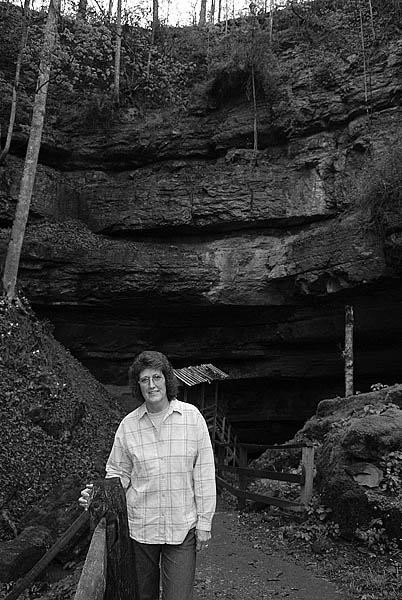
Janie Morgan at the entrance to Organ Cave, Greenbrier
County. She and her husband bought the cave at auction in 1994. Photograph
by Carl E. Feather.
Organ Cave
A World Within a World
Text and photographs by Carl E. Feather
Greenbrier County has nearly 1,200 known limestone caves, yet native Janie Morgan spent the first 45 years of her life without stepping inside one. Thus, when Organ Cave went to public auction in September 1997, Janie and her husband, Sam, were unlikely buyers for a property that had lost face with the community.
“When the cave came up for sale, we started asking people in the community about it, and they laughed at us,” says Janie. “The cave had never been kept up as far as the buildings or anything. It was in a pretty sorry state.”
Janie says the stairs that descend 100 feet to the mouth of the cave were rickety and dangerous; the cave itself had become a repository for refuse. Things were in sad shape above ground, as well. A dilapidated house trailer served as the gift shop, and a gutted trailer housed the restrooms, which lacked sufficient water flow to flush the toilets.
“There wasn’t a whole lot of interest in it,” she says. “At the auction, there were an undertaker, a retired man, and a lot of cavers who’d pooled their money to buy it.”
Sam reminded Janie that livestock, not bats and stalagmites, were their forte. Nevertheless, the price of livestock was tumbling, and the couple needed another revenue stream. Further, Janie had been dealing with a serious medical condition, and owning a commercial cave seemed a good fresh start for her life. When the bidding was done, Sam and Janie were the new owners of Organ Cave.
“We are livestock dealers, so we are used to purchasing things on the spur of the moment,” Janie says, sitting in the log cabin-style gift shop she and Sam erected shortly after buying the property. “I didn’t walk through it until after I purchased it. I knew of its history, and I did not want to see it destroyed. I did not want to see someone buy it and close it off.”
Sam, who suffers from osteoporosis and can’t tolerate the cave’s dank environment, gave Janie free rein of the cave. More than a decade after taking her first walk through it, Janie speaks of Organ Cave as a living organism, a fascinating world within a world where she can escape the cares of life above ground and, ironically, grow closer to God.
“When you are underground, you forget about this world up here. It’s rather amazing,” she says. “There are only two places remaining on this Earth that we have not completely explored: our oceans and our caves.”
Spelunkers began mapping Organ Cave’s myriad passages in 1948. The various maps created through the subterranean journeys of approximately 400 men and women have been combined and reconciled to document about 45 miles of passages. However, there are at least 200 unmapped leads.
“We don’t know how large the cave is, and it is doubtful it will ever be known,” says Janie, who has done her fair share of exploration. “You could probably spend the rest of your lifetime exploring it, and I don’t think you could ever accomplish it all in your lifetime.”
The second-largest commercial cave east of the Mississippi, Organ Cave gets its name from a massive calcite formation that resembles an auditorium size pipe organ, about 40 feet tall.
You can read the rest of this article in this issue of Goldenseal, available in bookstores, libraries or direct from Goldenseal.